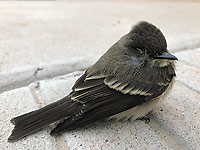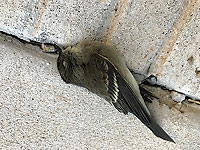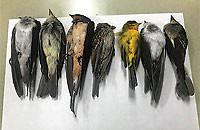 |
| Photo taken of lethargic unresponsive bird at 5:57pm MST at the Jornada Experimental Range Headquarters outside of Las Cruces, New Mexico |
You might have noticed the many news articles about dying birds found throughout cities and towns in Colorado, New Mexico, and Texas this month. While this sounds like the beginning of a movie about the apocalypse, it is likely just one symptom of a much larger global problem, one that we have been warned about for decades.
Beginning in mid-August, residents and biologists reported birds acting lethargic and were found perched on the ground, instead of in trees and shrubs where they are normally found. Most accounts end with finding those same birds dead. Furthermore, most of these birds were migratory and described as freshly molted juveniles believed to be amidst their annual migration south for winter. Warblers, sparrows, blackbirds, flycatchers, and western wood pewee and just a few of hundreds of thousands, possibly even up to a million, birds that were found dead in New Mexico alone.
There are countless hypotheses for the reason behind these massive migratory bird deaths. However, the leading ideas suggest a double punch of both declining bird populations since the 1970’s along with the multifaceted impacts of climate change in the western US.
 |
| Photo of same bird less than one hour later (6:41pm MST). Martha Desmond from New Mexico State University’s Department of Fish, Wildlife and Conservation Ecology has sampled many of the dead birds around Las Cruces, NM and sent these samples off to Wildlife Forensics Laboratory in Ashland, Oregon for further analysis. |
Bird populations have been declining since the mid-20th century (think Rachel Carson’s Silent Spring), and these deaths have mainly been attributed to the use of pesticides and large-scale land use change. One important food source for birds are insects. Unfortunately, however, 40% of all insect species are in decline and predicted to continue to be threatened in coming decades. While not all the of the migratory birds that have been found dead are exclusive insectivores, many, like the Yellow warblers (Setophaga petechia) rely on insects for gaining fat reserves to make their long journey from Canada to Mexico to winter in warmer southern climates.
Scientists have long predicted that migratory birds will continue to be threatened due to climate change. Bird migrations require feeding heavily during the day and fly-up to catch a ride on the jet stream at night. They can travel by jet stream for up to three nights straight and then come down to the ground again to feed and put on more fat. A changing climate can have multifaceted effects on bird populations. Scientists suspect that the hundreds of wildfires across the west this year may have forced birds into early migration. In addition, the extreme drought gripping the western US has additionally reduced seed production and insect populations even more this year, likely limiting their ability to consume enough calories for long-distance migrations. On top of the wildfires and drought, the sudden and extreme cold snap in the Rocky Mountain Region last week, may have been energetically costly for these young hungry birds.
 |
| A variety of the migratory birds collected from White Sands Missile Range and sites in Dona Ana County, NM. Photo by Martha Desmond (New Mexico State University) |
Massive die-off in bird populations can have cascading impacts on ecosystem processes. Migratory birds provide many benefits to ecosystems including pest control, pollination of plants, and are a food source to other wildlife. Birds also provide a unique recreation experience for millions of bird watchers and bird enthusiasts. Scientists have been warning us for decades that climate change will have dramatic impacts on ecosystems, here is just one of the many events we are likely to see in our changing world.
|